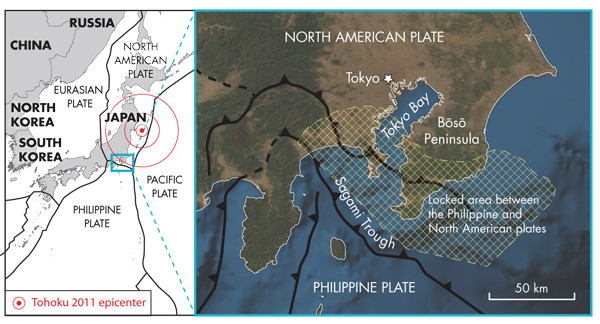
by Mary Caperton Morton Monday, July 21, 2014

Japan sits at the intersection of multiple tectonic plates. Just east of the island is a deep trench called the Sagami Trough. To monitor slow slip in the region, scientists are tracking the surface motion of the Boso Peninsula on the eastern side of Tokyo Bay, where the Philippine Plate plunges beneath the Eurasian Plate, creating the trough. Credit: Kathleen Cantner, AGI, after Ozawa et al., Geophysical Research Letters (2014).
To study plate movements under Tokyo, Shinzaburo Ozawa of the Geospatial Information Authority of Japan in Tsukuba used GPS sensors to track the surface motion of the Bōsō Peninsula on the eastern side of Tokyo Bay, where the Philippine Plate plunges beneath the Eurasian Plate, creating the Sagami Trough. His results were published in Geophysical Research Letters.
Between Dec. 28, 2013, and Jan. 10, 2014, GPS sensors detected a 10-centimeter shift between the two plates over the two-week period — that’s equivalent to the energy released by a magnitude-6.5 earthquake. The slip comes a little more than two years after the Bōsō’s last aseismic event, a month-long slip in October and November 2011. This recurrence interval is getting shorter, decreasing from 6.4 years in 1996 to 4.2 years in 2011, Ozawa says. The estimated moment magnitudes for the slow-slip events have remained relatively consistent: 6.7 in 2011, 6.6 in 2007, 6.6 in 2002 and 6.6 in 1996. Records of Bōsō’s slow slip only extend back to 1996 when GPS monitors were installed; seismographs do not record slow slip, which generally does not cause any damage, Ozawa says.
“The questions are when and how the next Bōsō slow slip will occur,” Ozawa says. “If the recurrence interval becomes shorter, which we think is unlikely, we will have to reconsider the underlying factors driving the Bōsō slow-slip area.”
Among Japanese researchers, the consensus has long been that the Bōsō Peninsula is completely aseismic, but that might not be a safe assumption, says Ross Stein, a geophysicist at the U.S. Geological Survey based in Menlo Park, Calif., who was not involved in the new study. “I think the Bōsō area is potentially capable of producing an earthquake around magnitude-5, but that’s a matter of debate. The Japanese cite a lack of seismicity in the historical record, but we’ve seen that the historical record, even in Japan, is too short.”
Part of the debate centers on whether slow-slip events increase or decrease stress in complex fault systems, like the one underlying Tokyo. “On the one hand, these slip events may be eating away at whatever increased stress was applied after the Tohoku event, but an increased rate of small to moderate quakes could also mean an increased probability of a larger earthquake happening down the line,” Stein says. “There’s no crystal ball, but the prudent position is to suspect that Tokyo is in play, more so than it was before Tohoku.”
The rest of the controversy revolves around how distant faults affect one another and whether the Tohoku event, the fifth-largest earthquake recorded on Earth, could have a significant effect on the faults under Tokyo. After Tohoku, seismicity in the Tokyo area increased tenfold, eventually leveling off at three times the pre-Tohoku rate. A study published last year in Geophysical Research Letters by Stein and his colleague Shinji Toda of Tohoku University in Sendai, Japan, estimated a 17-percent probability of a large earthquake striking Tokyo before 2018, a hazard profile two and a half times greater than before Tohoku. “In the earth sciences, observation should always trump theory,” Stein says.
But Ozawa, for one, isn’t ready to declare Tokyo under threat. “At present, we cannot say this [shortening interval] is a warning signal of a coming earthquake.”
The evidence, however, calls for vigilance, Stein says. “Tokyo is so important to Japan in every possible way that Tokyo being threatened is a major offense.”
© 2008-2021. All rights reserved. Any copying, redistribution or retransmission of any of the contents of this service without the expressed written permission of the American Geosciences Institute is expressly prohibited. Click here for all copyright requests.